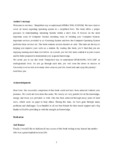OPERATING SYSTEM
Abstract
Modern general-purpose computers, including personal computers and mainframes, have
an Operating System to run other programs, such as application software. Examples of operating
systems for personal computers include Microsoft Windows, Mac OS (and Darwin), UNIX, and
Linux.
The lowest level of any Operating System is its kernel. This is the first layer of software
loaded into memory when a system boots or starts up. The kernel provides access to various
common core services to all other system and application programs. These services include, but
are not limited to: disk access, memory management, task scheduling, and access to other
hardware devices.
As well as the kernel, an Operating System is often distributed with tools for programs to
display and manage a graphical user interface as well as utility programs for tasks such as
managing files and configuring the operating system. They are also often distributed with
application software that does not relate directly to the operating system's core function, but
which the Operating System distributor finds advantageous to supply with the Operating System.
The delineation between the Operating System and application software is not precise,
and is occasionally subject to controversy. From commercial or legal points of view, the
delineation can depend on the contexts of the interests involved.
Like the term “Operating System " itself, the question of what exactly should form the
"kernel" is subject to some controversy, with debates over whether things like file systems
should be included in the kernel.
Operating Systems are used on most, but not all, computer systems. The Simplest
computers, including the smallest embedded systems and many of the first computers did not
have operating systems. Instead, they relied on the application programs to manage the minimal
hardware themselves, perhaps with the aid of libraries developed for the purpose. Commercially
supplied operating systems are present on virtually all modern devices described as computers,
from personal computers to mainframes, as well as mobile computers such as PDAs and mobile
phones.

